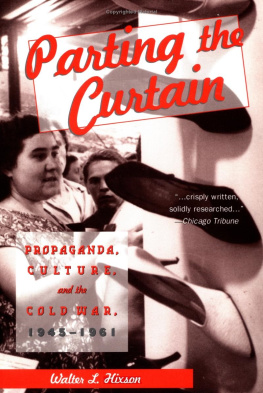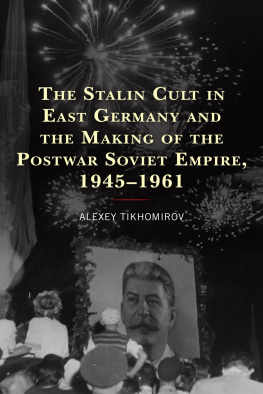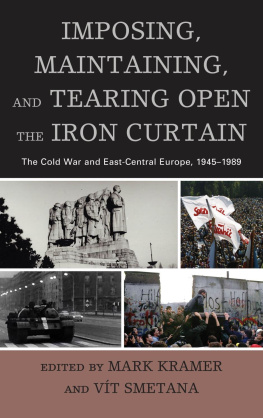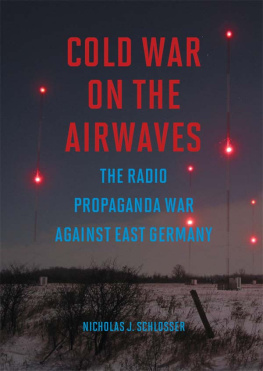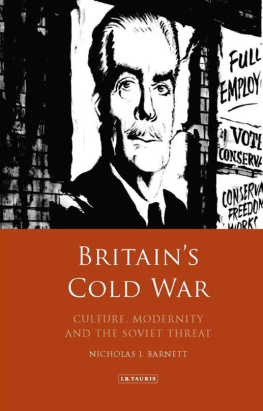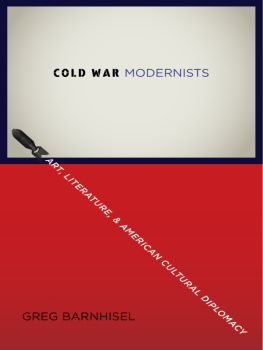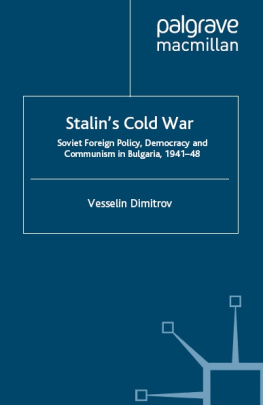PARTING THE
CURTAIN
PARTING THE
CURTAIN
Propaganda, Culture,
and the Cold War,
1945-1961
Walter L. Hixson
St. Martins Griffin
New York
PARTING THE CURTAIN: PROPAGANDA, CULTURE, AND THE COLD WAR Copyright Walter L. Hixson, 1997, 1998.
All rights reserved. Printed in the United States of America. No part of this book may be used or reproduced in any manner whatsoever without written permission except in the case of brief quotations embodied in critical articles or reviews. For information, address
St. Martins Press, 175 Fifth Avenue, New York, N.Y. 10010.
ISBN 0-312-17680-5 paperback
Library of Congress Cataloging-in-Publication Data
Hixson, Wlater L.
Parting the curtain : propaganda, culture, and the Cold War / by Walter L. Hixson, p. cm.
Includes bibliographical references (p.) and index.
ISBN 0-312-16080-1 (cloth) ISBN 0-312-17680-5 (pbk)
1. United StatesRelationsEurope, Eastern. 2. Europe, Eastern RelationsUnited States. 3. Propaganda, American. 4. United StatesForeign relations1945-1989. 5. Cold War. I. Title.
IN PROCESS
303.48273047dc20 95-52253
CIP
Design by Acme Art, Inc.
First published in hardcover in the United States of America in 1997 First St. Martins GrifFin edition: January 1998 10 987654321
CONTENTS
List of Abbreviations vii
INTRODUCTION
CHAPTER 1
CHAPTER 2
CHAPTER 3
CHAPTER 4
From Revolution to Evolution: The Thaw in East-West
Cultural Relations 87
CHAPTER 5
Peoples Capitalism: USIA, Race Relations,
and Cultural Infiltration 121
CHAPTER 6
From the Summit to the Model Kitchen: The Cultural Agreement
and the Moscow Fair 151
CHAPTER 7
Sue Weeks at Sokolniki: Soviet Responses to the American Exhibition 185
CHAPTER 8
Conclusions: Militarization, Cultural Infiltration, and the Cold War 215
Notes 235
Index 278
LIST OF ABBREVIATIONS
BBC British Broadcasting Corporation
BRE Brussels Exposition
CIA Central Intelligence Agency
CP Communist Party
CPSU Communist Party of the Soviet Union
CPI Committee on Public Information
CCF Congress for Cultural Freedom
ECA Economic Cooperation Administratio n
FEC Free Europe Committee
GDR German Democratic Republic (East Germany)
HCUA House Committee on Un-American Activities
ITU International Telecommunications Union
IIA International Information Administration
MIT Massachusetts Institute of Technology
MPAA Motion Picture Association of America
NATO North Atlantic Treaty Organization
NSC National Security Council
OCB Operations Coordinating Board
OWI Office of War Information
OSS Office of Strategic Services
PSB Psychological Strategy Board
PWD Psychological Warfare Division
PAO Public Affairs Officers
RFE Radio Free Europe
RIAS Radio in the American Sector [of Berlin]
RL Radio Liberation (renamed Radio Liberty in 1964)
SFRC Senate Foreign Relations Committee
Un United Nations
UNESCO United Nations Educational, Scientific, and Cultural Organization
USIA United States Information Agency
USIS United States Information Service
VOA Voice of America
VOKS Soviet Society for Cultural Relations with Foreign Countries [Soviet]
VDNKh Exhibition of the Peoples Economic Achievement
VFC Volunteer Freedom Corps
INTRODUCTION
Cultural Infiltration
and the Cold War
T
his study focuses on American propaganda and cultural infiltration targeting Eastern Europe and the Soviet Union from the end of World War II through the Eisenhower years. Although these efforts usually remained on the periphery of Cold War strategy, I have found that they were more significant than generally recognized. Washington sought to destabilize the Soviet and East European Communist Party (CP) regimes, first through psychological warfare and then through an ultimately more effective, albeit longer term, program of gradual cultural infiltration. Despite misperceptions and a lack of priority accorded to such efforts, Washington had succeeded in parting the Iron Curtain by the end of the Eisenhower years.
I am concerned primarily with official U.S. government efforts to use propaganda and culture to challenge CP authority in Eastern Europe and the USSR. While I do pay attention to private initiatives and informal cultural exchange, my primary focus is on propaganda and culture as components of national security policy. I make no systematic effort to analyze how the Cold War shaped American society, although some excellent scholarship exists on that subject. 1 Nor am I interested here in the impact of Soviet propaganda and cultural efforts in the United States, which appears minimal in any event.
Specialists in the history of the Cold War, like American policymakers themselves, have kept cultural matters on the periphery of their work. While American historians have analyzed domestic wartime propaganda, they have devoted less attention to its dissemination abroad. Despite some revealing scholarship on the impact of U.S. culture abroad in the prewar years, cultural diplomacy has yet to receive the attention it deserves. 2 No systematic study exists on efforts to use propaganda and culture as weapons in the Cold War. Memoirs and participant accounts dominate the literature on radio propaganda, the use of film, printed material, international exhibitions, and cultural exchange programs. 3
A good case can be made for the value of a cultural approach to international history in general, and to the Cold War in particular. First, however, we must explain what is meant by the elusive term culture, which one scholar has called, perhaps with only slight exaggeration, one of the two or three most complicated words in the English language. 4 Progressively expansive definitions of culture transcend a narrow focus on works of a high artistic, literary or intellectual character. The broad anthropological thick description of culture, incorporating all genres and modes, seeks to identify the core values, structures of meaning, or the ethico-mythical nucleus of a given society. Another definition, close to the one I employ here, views culture as indicative of a way of life of a group or society. Such a definition would include consideration of popular and consumer culture. 5
While scholars study culture to understand individual societies, another level of analysis seeks to explore the transmission and dissemination of culture across international boundaries: in other words, international relations as intercultural relations. At issue here is the sharing and transmitting of consciousness communication of memory, ideology, emotions, lifestyles, scholarly and artistic works, and other symbols. 6 International historians, accomplished in studying the roles of power and economic forces in world politics, have only recently begun to analyze what many perceive as the third layer of analysis, namely culture. Just as historians assess the rise and fall of states based on their military power and economic influence, the cultural influence of nations must be considered as well. What historians can do," explains Akira Iriye, is examine the evidence to see whether it may be said that in certain periods of history cultural issues do become critically important, even as in other periods security or trade may overshadow other factors. 7
It is becoming increasingly clear that American mass culture has been one of the countrys greatest foreign policy assets. Aided and encouraged by the federal government, cultural expansion has increased throughout the twentieth century. The emergence of the United States as the most advanced consumer society in the world accounts for much of the appeal of the nations culture abroad. As Emily Rosenberg has explained, Through the international marketing of consumer products identified as American, America itself became a code of modernity and consumer lifestyles. The nations rise to world power was inextricably linked with the dissemination of images of affluence, consumerism, middle-class status, individual freedom, and technological progress. The appeal of American mass culture facilitated overseas expansion and identified the United States with progress. Not only in Western Europe but throughout the world cultural transmission facilitated the emergence of what Gertrude Stein, and later Henry Luce, called the American Century. 8
Next page
